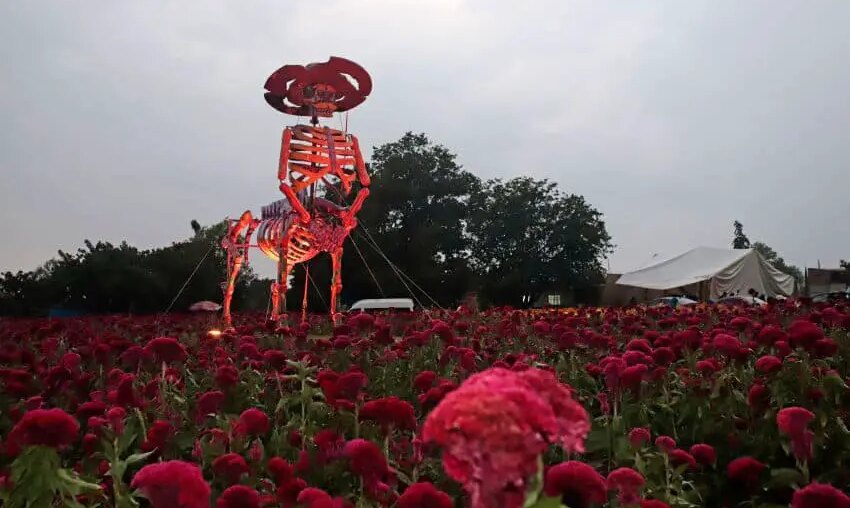Day of the Dead is arguably the most dynamic, unique and spectacular showcase of Mexican culture. I’ve spent the last several years enjoying the colorful celebration in Mexico City and, while lovely, it just doesn’t quite capture the family element I’ve been looking for. I decided in September that this would be the year that I’d hit the road in search of golder pastures, heading to a place that represented both sides of the coin: artistic creation and authentic reverence. So I made my way to Puebla, one of Mexico’s most culturally rich states and home to Atlixco, the City of Flowers.
Absolutely dripping in marigolds and Day of the Dead decor, this Pueblo Mágico regularly draws tourists for its year-round warm and humid climate. It’s about a 30-minute drive from Puebla city and boasts magnificent views of the surrounding mountains, including the beloved Popocatépetl volcano. Late October is a particularly attractive time of year to visit, as Atlixcans truly go all out for the holiday.
The Valle de Catrinas project started in 2021 with five giant skeleton statues adorning various streets and strategic corners of town. This year, that number has jumped to 15 fantastical figures representing important figures in Mexico’s history, like Emiliano Zapata.
Atlixco’s stunning Day of the Dead in pictures
![]()
![]()
Also present was Porfirio Díaz, who ruled Mexico in the late 19th and early 20th centuries leading up to the Mexican Revolution.
![]()
![]()
Cuauhtémoc, the last king of the Mexica Empire, was also represented.
![]()
![]()
Revolutionary leader Pancho Villa was also represented, with a very literal homage to his nickname, the Centaur of the North.
![]()
![]()
As is the custom, many shops, hotels and restaurants showcased not just catrinas, but also elaborate altars for visitors to enjoy.
Atlixco’s popularity as a wedding destination led locals to create “La novia de Atlixco,” or the bride of Atlixco.
![]()
![]()
This classic, stylish catrina greets visitors at the entrance of Casa de la Audiencia, a 16th-century building that now serves as an upscale hotel.
![]()
![]()
Through social media, visitors uncovered a hidden altar at Xolo Mezcalería.
![]()
![]()
Artist Omar Rangel’s monumental altar at Molino de San Mateo wasn’t just a creative masterpiece – it included an interactive screen for visitors to project photos of their loved ones.
![]()
![]()
Rangel also constructed a 5-meter-tall altar made solely of bread.
![]()
![]()
Just a 40-minute ride away is the charming town of Huaquechula, renowned for its majestic altars. Starting in the town’s main square, visitors can follow the journey of a soul from death to the afterlife.
Start in the graveyard, where “causes of death” are written on simple grave markers. This poor soul seems to have suffered dire consequences after some WhatsApp messages came to light.
![]()
![]()
Souls make their way along the river Apanohuaia on small, brightly-painted boats, dodging potential dangers with the help of the small but mighty Xolo dog. This is just one of nine harrowing stages the dead must pass in order to reach the afterlife.
![]()
![]()
A golden path of flowers insinuates that the afterlife has successfully been reached.
![]()
![]()
Some homes were open for the public to enter and pay their respects.
![]()
![]()
Upon return to Atlixco, I couldn’t leave without climbing Mirador de Cristal on Cerro de San Miguel. I left my hotel on the outskirts of the Zócalo and made my way uphill. The walk was, by all standards, very pleasant.
Parroquia de Santa María de la Natividad is a few blocks away from Atlixco’s main square and looks like an elaborately-decorated cake.
![]()
![]()
The arts and crafts market takes over a small alley just off the Zocalo.
![]()
![]()
Avenida Hidalgo, also known as flower street, is full of shops and eating establishments, all which were decorated to the nines for the holiday.
![]()
![]()
Atlixco is quite lovely to stroll before 9:00 a.m. It’s a sleepy town, with few cafes opening earlier than that.
![]()
![]()
There are street murals everywhere, many created by local artist Juan Manuel Martínez Caltenco.
![]()
![]()
The uphill walk to the Mirador Cristal is lined with scenic views and beautiful flowers.
![]()
![]()
How to reach Atlixco from Mexico City
Take the E-Bus to Paseo Destino, Puebla, which takes between two to three hours. From here, you can Uber about 30 minutes to the center of Atlixco. Alternatively, you can take the ADO bus line from TAPO to CAPU, Puebla’s central station. From CAPU, take the ORO bus to Atlixco’s city center, about 30 minutes.
Upcoming festivals in Atlixco
Christmas Lights Festival (Brilla Fest): Nov. 15 – Dec. 30
Holy Week (Semana Santa): April 14 – 25
Bethany Platanella is a travel planner and lifestyle writer based in Mexico City. She lives for the dopamine hit that comes directly after booking a plane ticket, exploring local markets, practicing yoga and munching on fresh tortillas. Sign up to receive her Sunday Love Letters to your inbox, peruse her blog, or follow her on Instagram.

